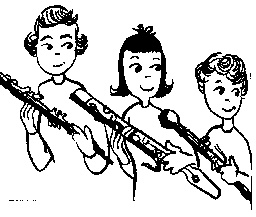It's Easy To Make Music
How To Play the Oboe, Bassoon And english Horn
| Share page | Visit Us On FB |
THE OBOE, BASSOON AND ENGLISH HORN

Like the clarinet, the oboe, bassoon and English horn are reed
instruments on which the tone is produced by causing a reed
to vibrate. All three of these instruments are indispensable to
a symphony orchestra, but are seldom used for solo work or
for playing popular music. They are played on the same gen-
eral principles as the clarinet.
The oboe is the treble member of the wood wind instru-
ments and has a double reed mouthpiece, which is quite hard
to learn to use. Its range is from Bb below the treble staff to
high F, and it has a distinctive thin, reedy tone. The oboe's
name comes from the French word hauthois, meaning "high
wood" or high-pitched wood wind instrument. In early days
the oboe was commonly called the hautboy, and this was
gradually modified to oboe.
The bassoon also has a double reed mouthpiece and is a
member of the oboe family of which it is the bass. That is how
it got its name, which indicates that it is the big bass of the
wood wind instruments. It is a large instrument about four feet
long, and its mechanism and fingering are very intricate. The
notes are produced by using the fingers on seven holes and
seventeen or nineteen keys. The bassoon has a tremendous
range, which extends from Bb below the bass staff to Ab in the
second space of the treble staff or by means of an additional
mechanism to C or even F. Partly because of this and partly
because of its unique deep tones, the bassoon has been a great
favorite with many of the master composers such as Beethoven,
Mozart and others.
114